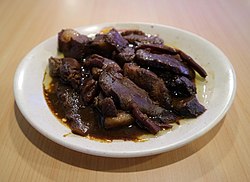 Babi hong, a Chinese Indonesian pork belly dish in Chinese sauces and seasonings. | |
| Course | Main course |
|---|---|
| Place of origin | Indonesia |
| Region or state | Chinatowns in Indonesia |
| Created by | Chinese Indonesians |
| Serving temperature | Hot |
| Main ingredients | Pork belly braised in soy sauce, garlic and Chinese sauces |
| Similar dishes | Babi kecap, red braised pork belly |
Babi hong is a Chinese Indonesian pork belly dish possibly of Hakka origin. [1] The samcan or pork belly is boiled or braised, fried and steamed in numbers of Chinese seasonings and sauces. [2]
Contents
Babi hong is often offered in Chinese Indonesian restaurants, especially in Chinese towns in Indonesian cities. [3] Traditionally this dish is considered as a special dish to be served to guests and family during special occasion such as imlek (Chinese New Year).
Babi hong is quite similar to other Chinese Indonesian pork dish – babi kecap (pork braised in soy sauce), although babi kecap is a much simpler dish. It is quite similar – possibly related to Hakka dish kiu nyuk and mainland Chinese pork belly dish hong shao rou .